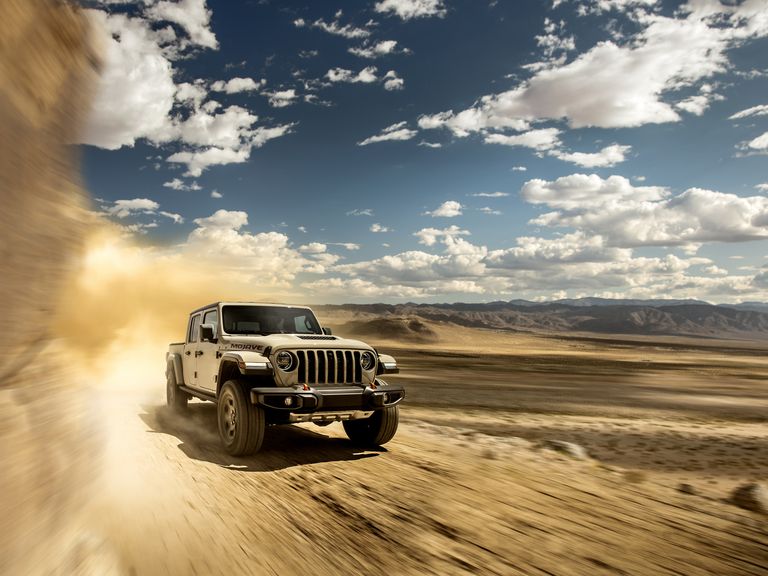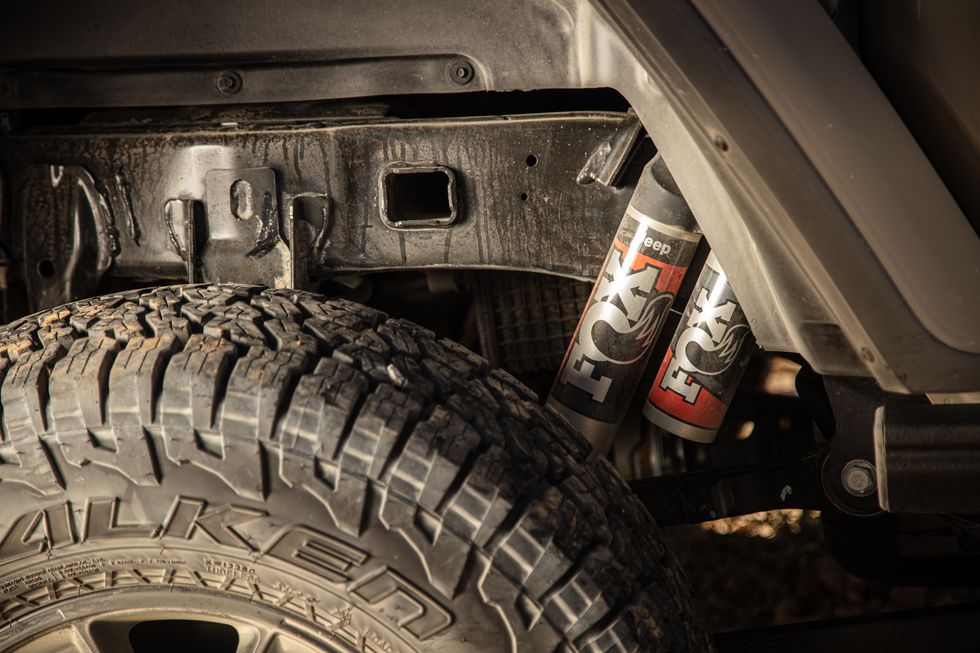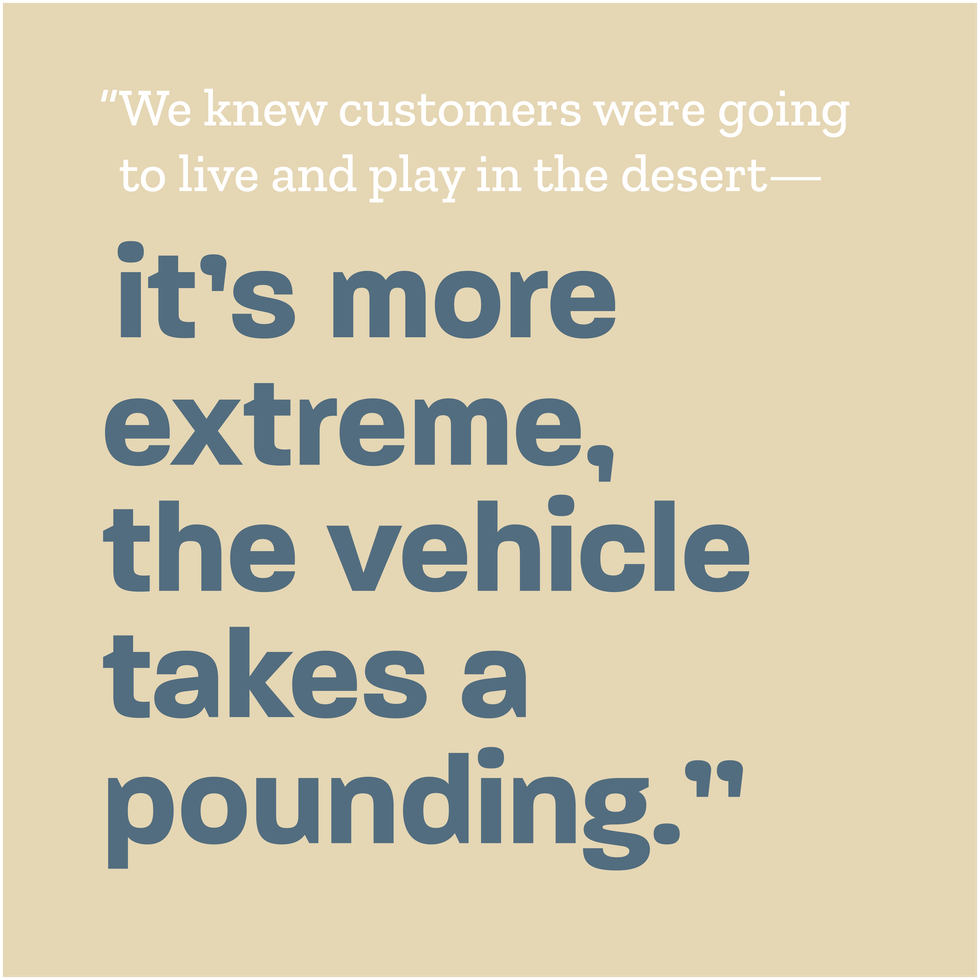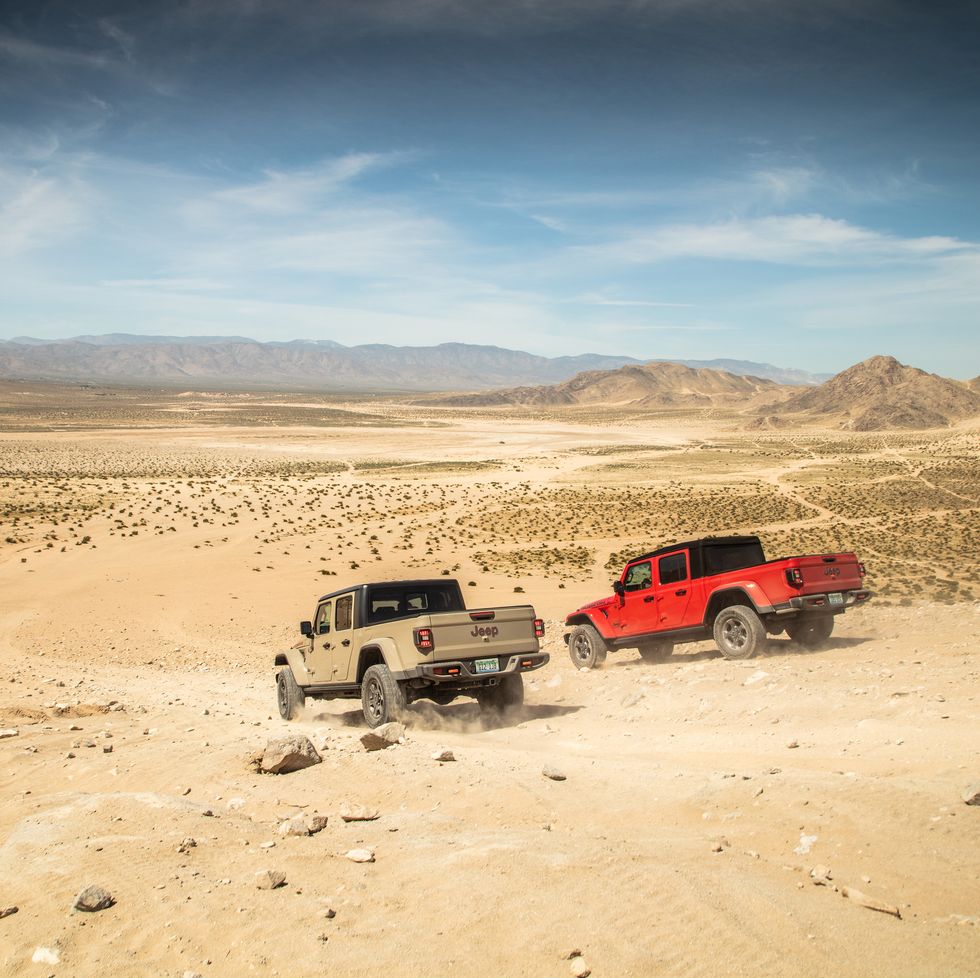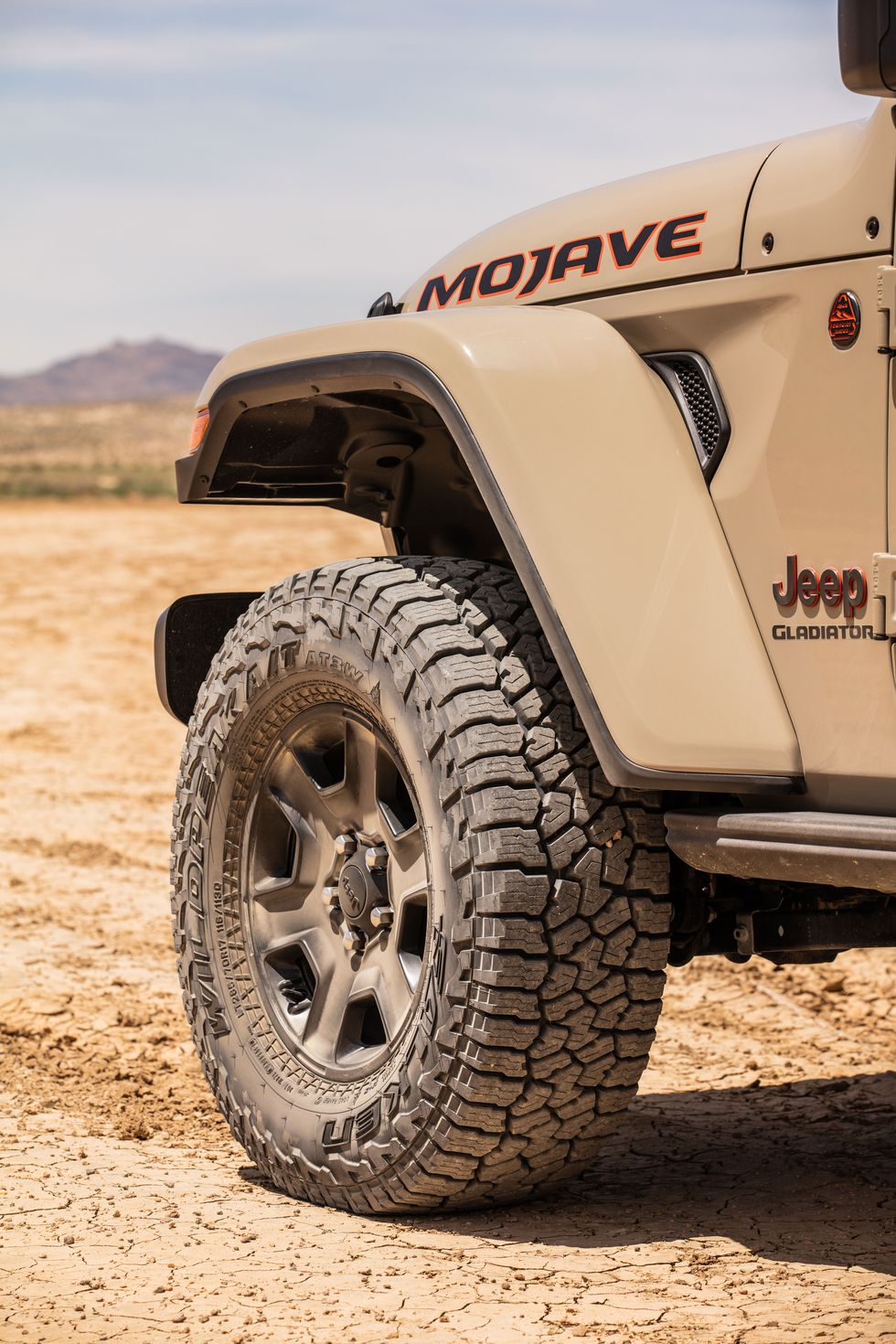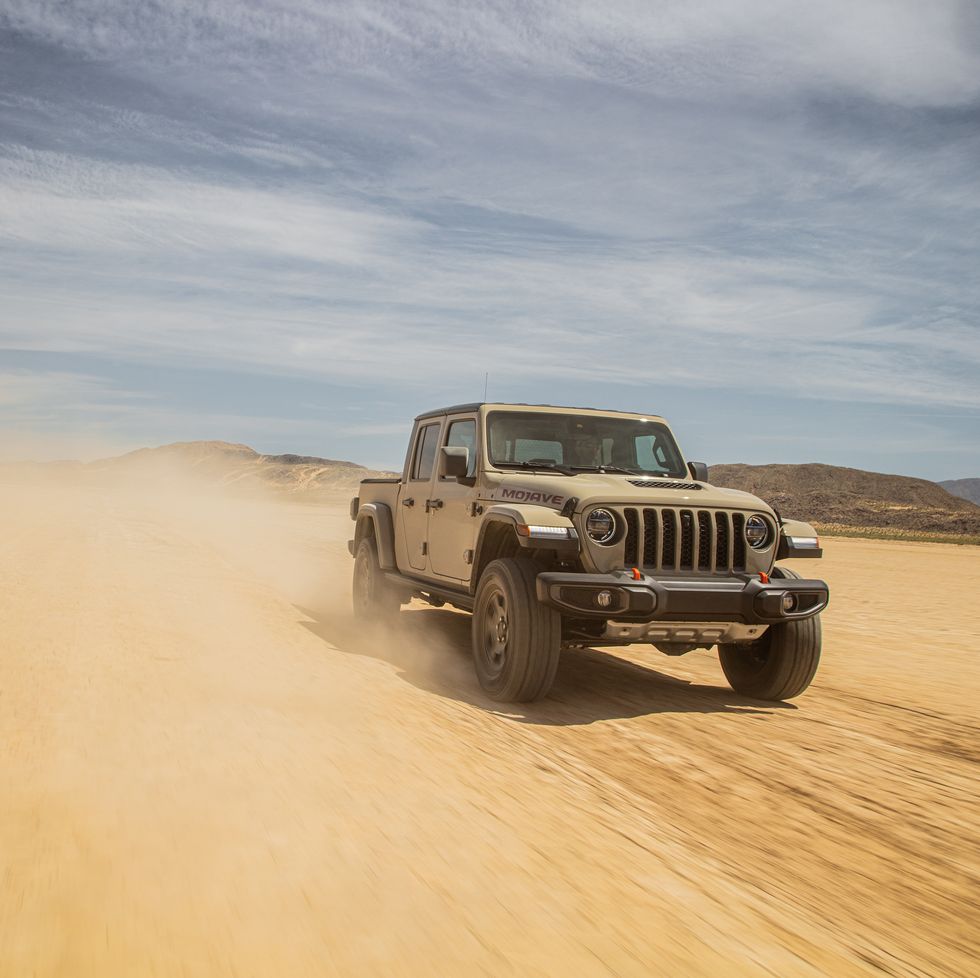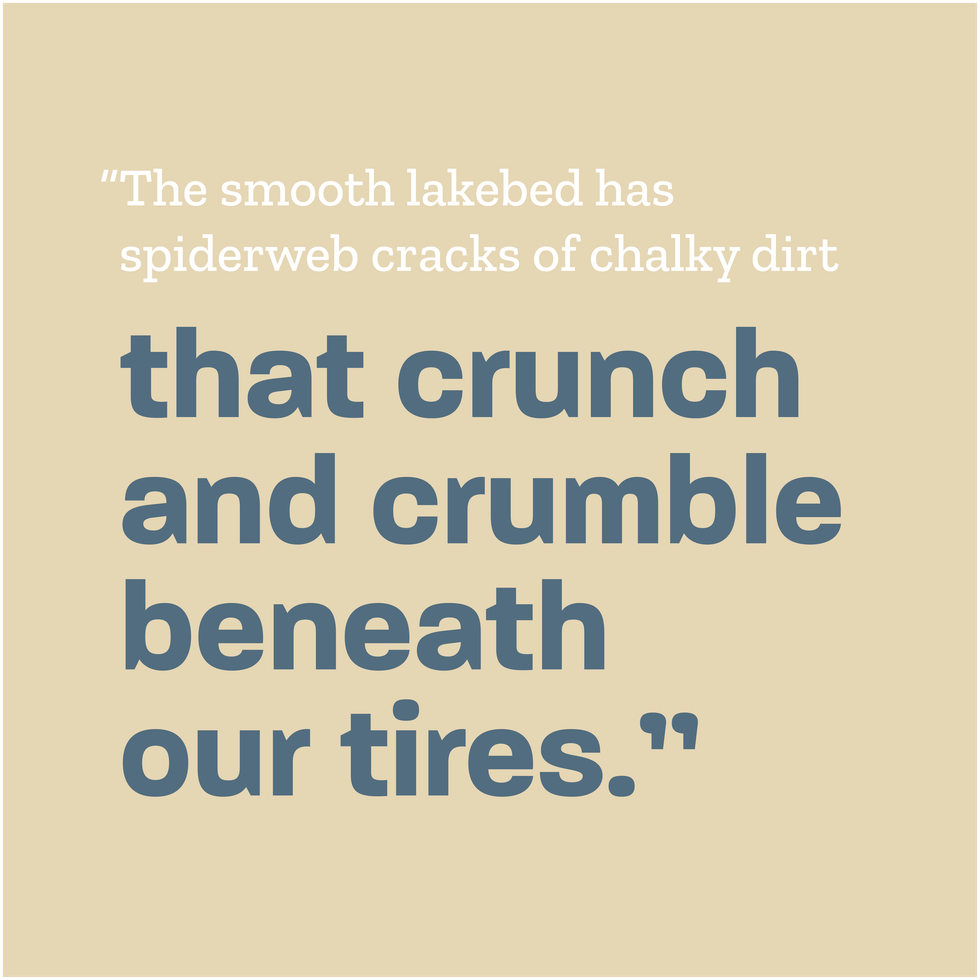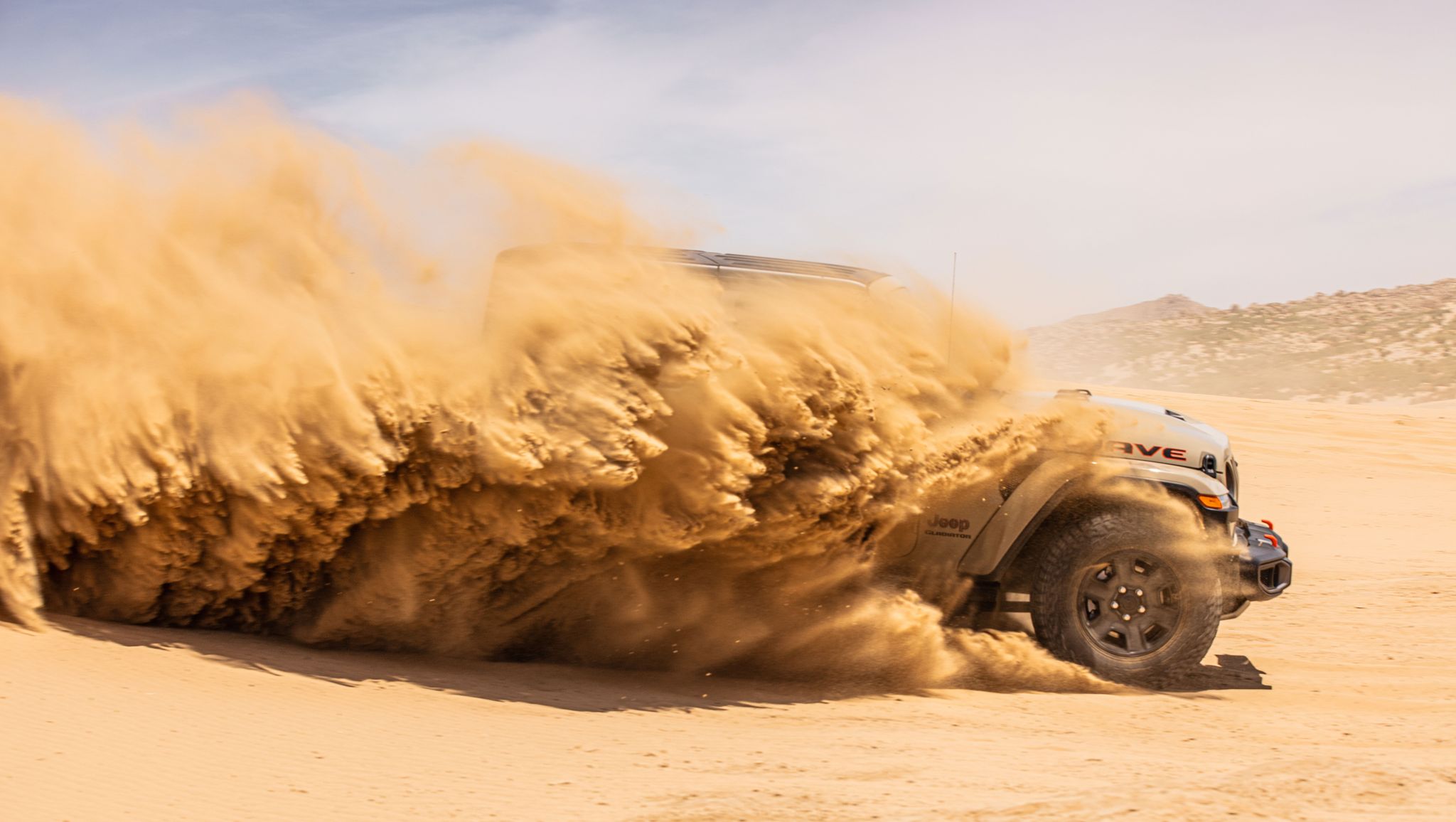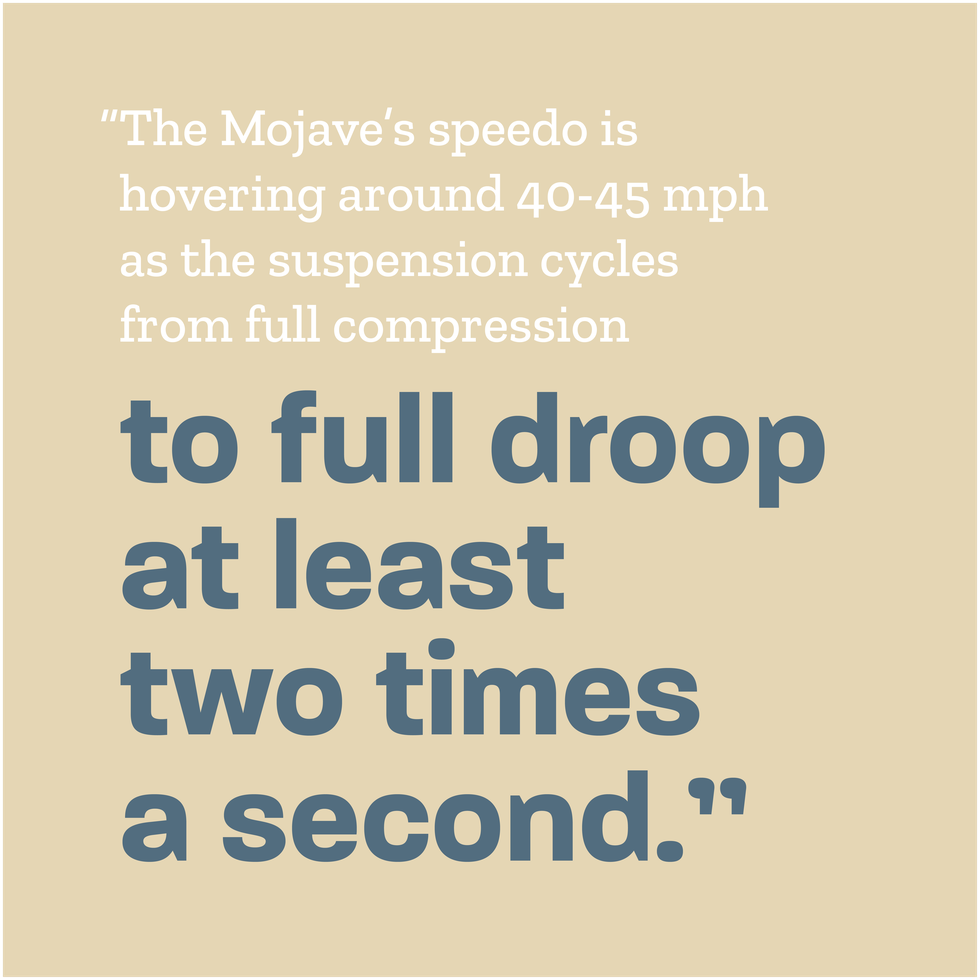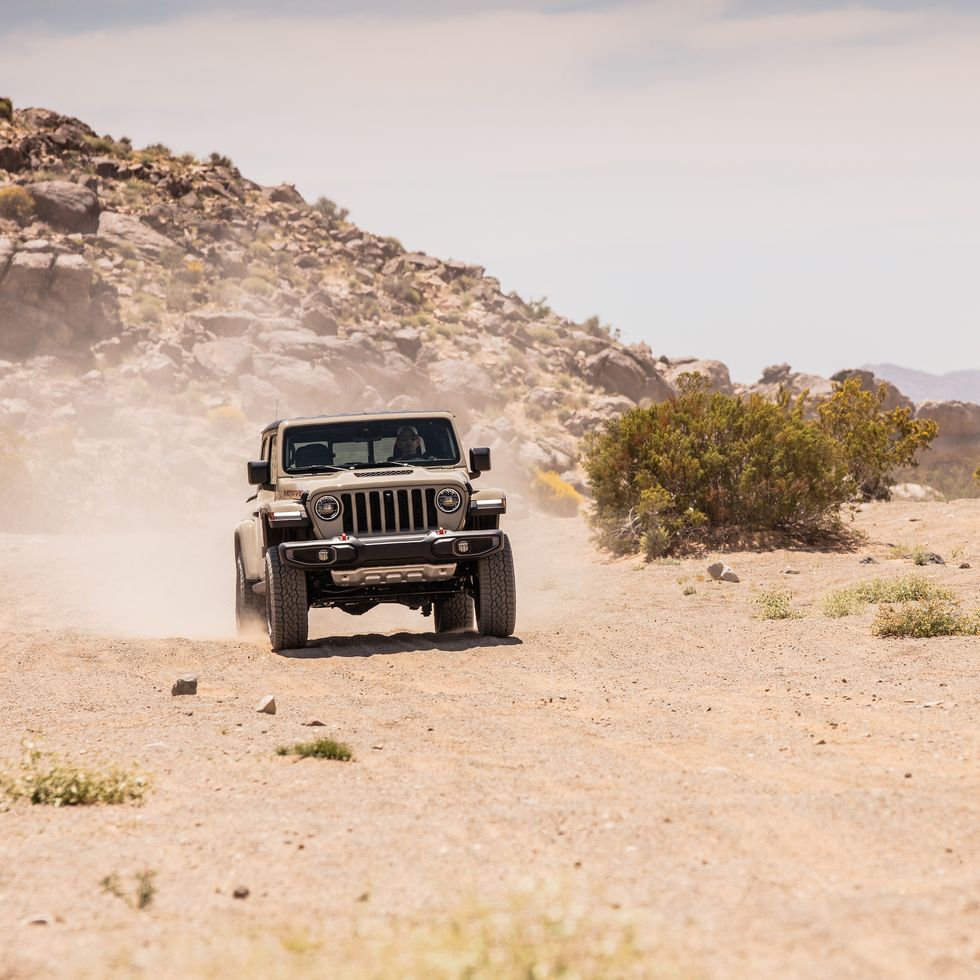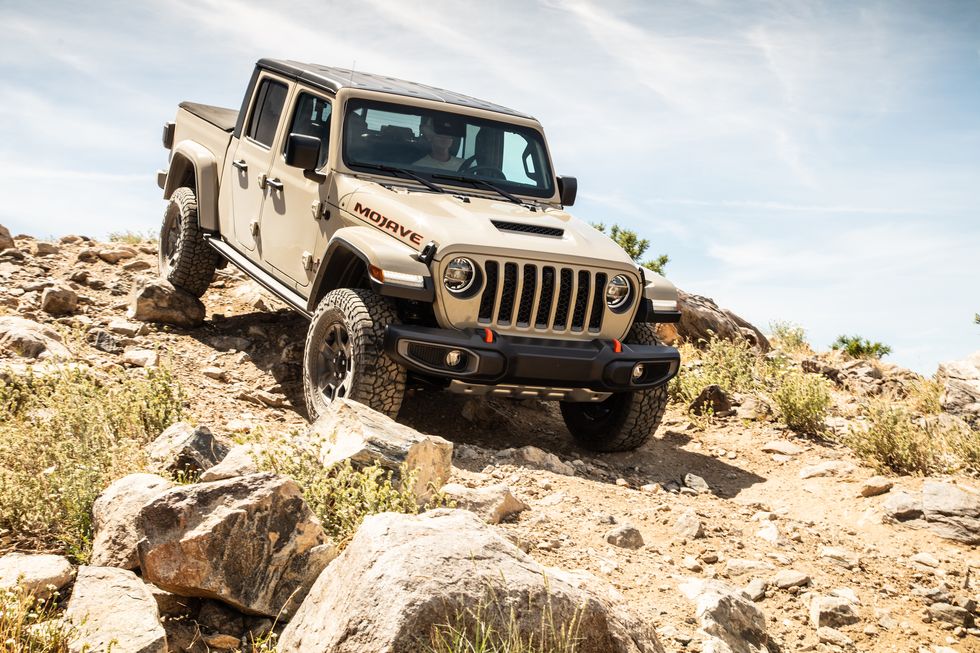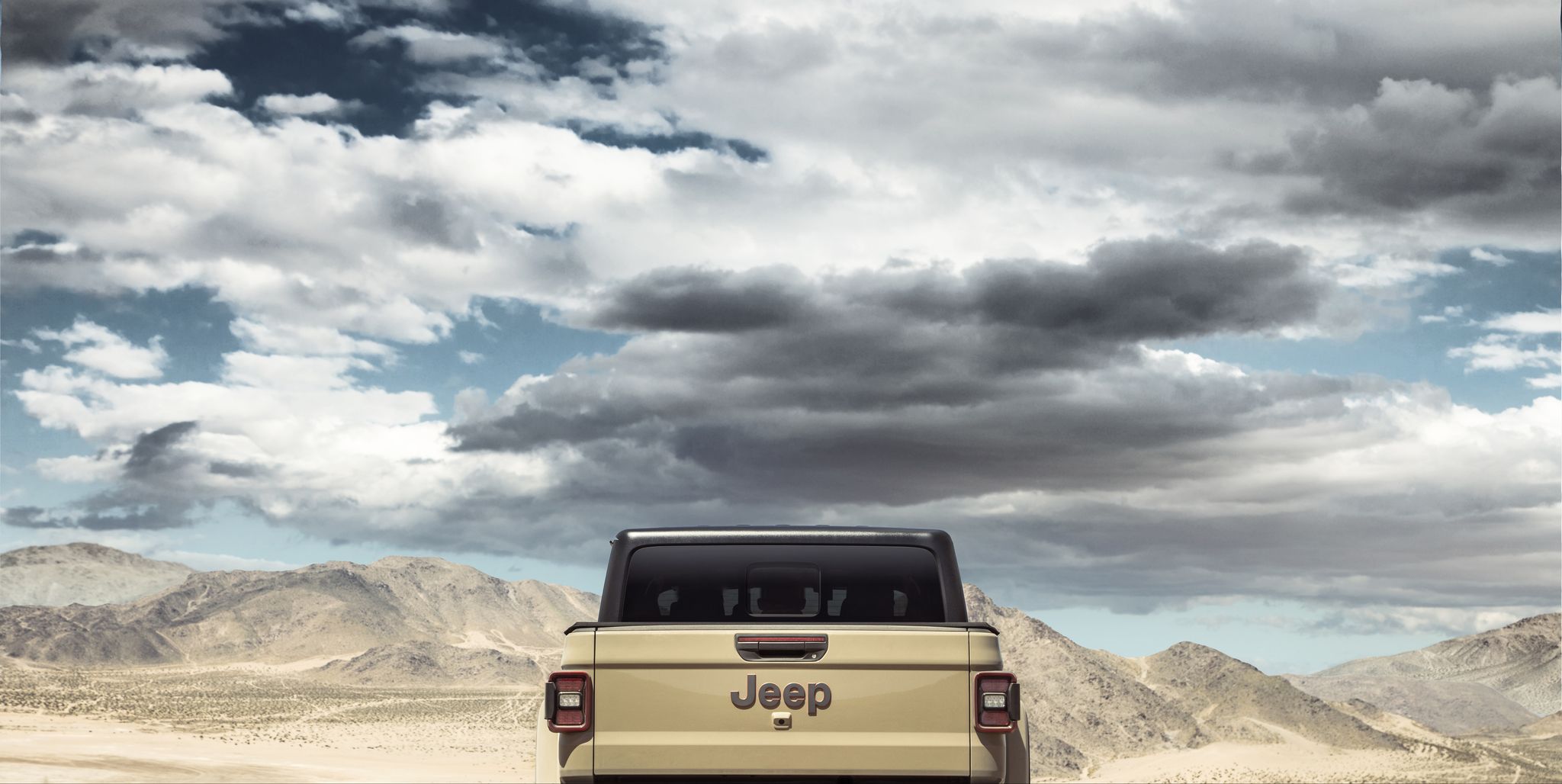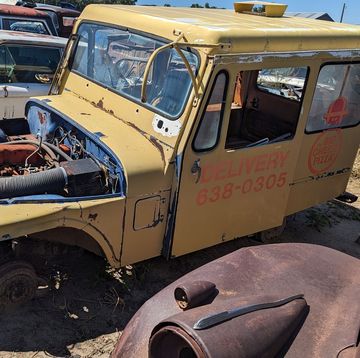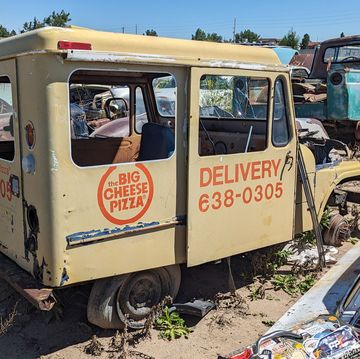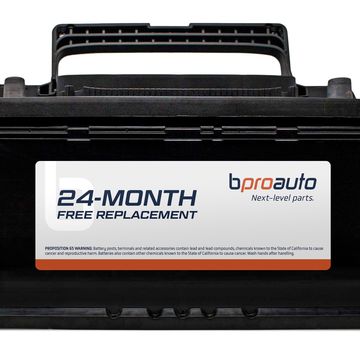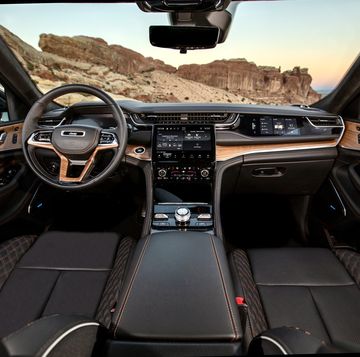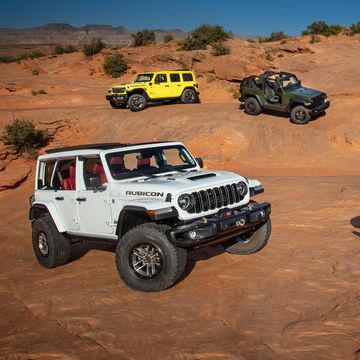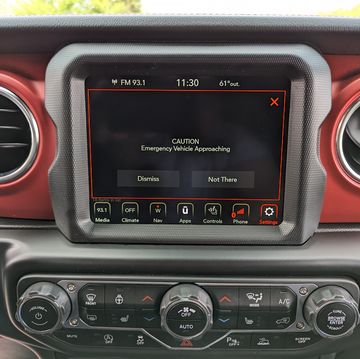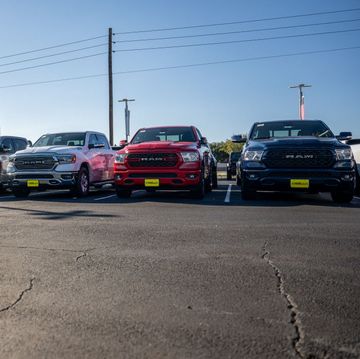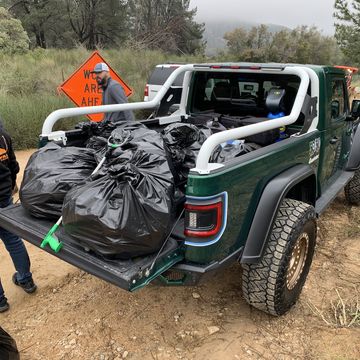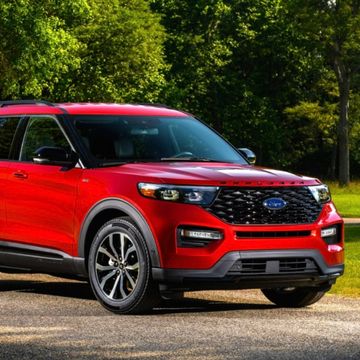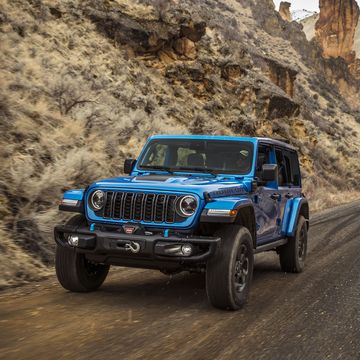Cell service cuts out not long after you peel off the pavement. It’s a friendly reminder that this is a remote chunk of the Mojave Desert and if your vehicle dies out here—so might you. If you’re testing in these desolate parts, you’d be wise to bring along another Jeep, along with a Warn recovery kit, Maxtrax sand traction boards and enough bottled water to fill a kiddie pool.
It’s the perfect setting in which to test out the 2020 Jeep Gladiator Mojave. It’s where the brand’s first “Desert Rated” offering was developed and honed, to start. The place was such an integral part of the new Jeep’s development that it took the desert’s name.
These days, that’s no small thing: Names used for most new vehicles are superficial—focus-grouped to sound cool, or at least inoffensive. They don’t have a deeper meaning. In fact, some mean nothing at all. But if the history of the “Rubicon” badge is anything to go by, Jeep’s name for the desert-proven version of the Gladiator pickup carries more weight, substance and authenticity than most.
“We spent a great deal of time testing in the Mojave Desert,” says Gladiator chief engineer Pete Milosavlevski. “We were looking for a codename and so the engineers naturally landed on ‘Mojave.’ It became the nomenclature within our ranks and just stuck.”
Jeep has a tradition of naming its most capable vehicles after places that push 4X4s to the breaking point. When the company puts those 3-inch tall R-U-B-I-C-O-N letters on the side of a Wrangler or Gladiator hood—it not only means those vehicles can tackle the Rubicon Trail itself but also just about any other slow-speed trail in the country. The Gladiator Mojave’s mission is just as hardcore, but the terrain is a little different.
“There’s always been the segment of our fanbase that wants to go fast in the desert,” says Milosavlevski. “So, when we decided to do the truck, it felt natural because this segment of customer (midsize truck) has a passion for it.”
The Gladiator Mojave is the first vehicle in Jeep’s lineup to be “Desert Rated.” And like the name Mojave itself, the Desert Rated badge has credibility, too. Jeep says it means this is a rig focused on the demands of higher-speed off-roading and must meet certain requirements in five categories: ride control and stability, traction, ground clearance, maneuverability and desert prowess. Jeep plans to offer Desert Rated versions of their other vehicles from the Compass on up to the Grand Cherokee.
So, what exactly makes a Mojave special? More stuff than you might imagine. On the inside, the Mojave wears new seats with supportive bolsters as well as a thicker steering wheel. The bodywork uses the same big flares as the Rubicon to fit the 33-inch-tall tires. And they’re wrapped around 17-inch wheels that have a unique offset that increases track width by half an inch over the Rubicon for stability.
Under the metal, Mojave has stronger axles with cast-iron steering knuckles up front and thicker tubes in the rear. In fact, the rear axle tubes went from a 6.25mm wall thickness on the Rubicon to 10.5mm on the Mojave to resist fatigue. The frame is beefed up at suspension mounting points to take more abuse, too, and there’s a steel skid plate up front that acts as a welcome mat for hard landings. The front springs in a Mojave are 1 inch taller than those on the Rubicon and provide more upward (jounce) travel to soak up desert obstacles. The rear springs have a softer spring rate to smooth the ride in the rough.
But the most transformative pieces of equipment come from Fox Racing Shox. The Rubicon models currently wear the company’s shocks, too. But the new 2.5-inch dampers on the Mojave are larger and use an internal bypass design with remote fluid reservoirs front and rear to help dissipate heat.
“The Mojave has our internal bypass technology that allows you to have position sensitivity for your damping. So when you’re very close to ride height you can be plush and pliant,” says Alex Hague, engineering manager for OE and aftermarket development for Fox. “And then, as you start getting towards the bottom-out or top-out zone, it changes the amount of bypass and that will ramp up the forces so you really have the capacity that’s required to go over large events.”
And the Mojave uses Fox’s high-tech hydraulic bump stops. Most trucks use a simple low-tech hunk of rubber or polyurethane as the suspension’s last stop before breakage. And the ride can be brutal at the limit.
“It’s a big financial decision for an OEM to put those (hydraulic bump stops) on there. They really wanted us to prove to them how good they were,” says Hague. “So we did back-to-back rides with and without our jounce bumpers, and it was so night and day—they were sold on it.”
The Mojave has a unique antiroll bars, too, that allow a bit more twist. There’s also an electronically locking rear differential. Opting for the Mojave means you won’t get the Rubicon’s disconnecting front antiroll bar, 4:1 transfer case or front electronic locking differential. It’s a tradeoff buyers will have to weigh because the two models are priced right on top of one another.
Testing Protocols
The Mojave may be hitting dealers later than the rest of the Gladiator lineup, but it’s been in the product plan from the beginning. Milosavlevski says the team spent more time validating the Mojave’s suspension and used unique terrain to do it. Engineers logged countless hours at the company’s Yucca, Arizona, proving ground. That’s where the stronger axles and frame modifications came from.
“We knew customers were going to live and play in the desert—it's more extreme, the vehicle takes a pounding,” said Milosavlevski. “So, we developed a unique durability duty cycle and quickly realized we needed to make some changes.”
Once major component failure was no longer a concern, the team hit the dirt in the real world. Engineers zeroed in on some of the most challenging parts of the California desert to dial in the Mojave’s chassis. At the time, the Gladiator was still a secret. Giant 18-wheelers loaded with prototype Mojaves, tools, spares and supplies would rumble into small desert towns. Engineers would quickly offload the camouflaged Gladiators and sock them away safely inside warehouses. The team brought along everything they’d need for testing and used these buildings as makeshift garages.
“Fox would come out with their trailer packed with equipment so that we could swap out shocks or adjust the shim stack. It was really a collaborative experience,” said Milosavlevski. “Leading up to a suspension development freeze, they (suspension engineers) would be there for a month at a time working six days a week, probably 12 hours a day—tuning.”
He says the team specifically outfitted the Gladiators for this type of testing with roll cages and five-point harnesses. Laptops and test gear were mounted to the cage with heavy-duty bracketry. To gather data, the trucks were equipped with accelerometers, g meters and thermocouples to record shock temperatures.
“Here you are in the middle of nowhere only working with the tools you brought,” says Milosavlevski. “You have to maintain the camouflage and the security of the vehicle, it’s 120 degrees outside and the sun is baking everything. Those are the things that makes it extra tough for the engineers.”
Dusty Trails
So, did all that testing pay off? To find out, we trekked deep into the desert to follow right in the tire tracks of the Jeep chassis engineers. Yep, we tackled some of those very same trails they used to tune the suspension in our Mojave tester: The team forwarded along the GPS coordinates for their test route in the Johnson Valley. You might remember that location as the location of the King of the Hammers, or KOH, a one-day off-road torture fest than mixes high-speed desert racing terrain with boulders, ledges and steep drops. It’s nuts. The 96,000-acre Johnson Valley OHV area is massive and if the rough terrain isn’t enough, it borders a live-fire training area used by the U.S. Marine Corps Air Ground Combat Center. Gulp.
“You get a little bit of everything there: loose sand, a dune climb, undulating whoops and the dry lakebed where you can take it up to 80-90 mph,” says Milosavlevski. “That’s what drove us to this area.”
So, with our virtual route map we traced about half of Jeep’s 70-plus-mile validation route and spent the better part of a day sucking dust. It was a blast. To get a true sense of what the Mojave could do, we brought along a Rubicon for comparison. Both are equipped with a V6 and automatic transmission. But make no mistake, there’s a big difference between these two when it comes to driving in this terrain.
Crawlin’ and A-Climbin’
Means Dry Lake is the main gathering spot for KOH. And when thousands of off-roaders are camped here, the area is aptly named “Hammertown.” Today, it’s desolate, dry and hot. The Mojave’s thermometer reads 93 degrees. The smooth lakebed has spiderweb cracks of chalky dirt that crunch and crumble beneath our tires.
Our GPS points the Mojave’s nose toward a mountain range to the east. Windows down was a mistake—the dust gets everywhere. We make the executive decision to spend the rest of the day with the A/C on in comfort. We’re wimps, but we’re happy wimps. Immediately to our right is Chocolate Thunder—a steep, short and gnarly rock crawling trail that’s flanked by hulking boulders as it climbs. The Gladiators are capable, but perhaps not that capable. Plus, it’s not where the Jeep guys went.
Instead, we head to the left and follow the electronic bread crumbs up an equally steep climb to the top of the ridge. Here, we do some back-to-back comparisons between the Mojave and Rubicon. The rocks are big, sharp and loose, so we’re in low range. The Rubicon has a smoother ride—especially with the front antiroll bar is disconnected. The ’Con’s suspension soaks up the pointy rocks with a gentle rocking from side to side. The Mojave is a bit more jarring as it hits the boulders. Where the Rubicon’s suspension feels a little loose and wallowy, the Mojave is controlled, if less comfy. If we had to load one of these trucks down with a camper shell, roof tent and 600 pounds of gear for overlanding, the Mojave would be our pick.
The Rubicon has lower overall gearing thanks to its 4:1 transfer case, so we’re better able to control the Jeep’s speed up and down this climb. The ’Con allows you to cruise down a steep trail without touching the brake pedal. But the Mojave’s taller gearing, thanks to the 2.72:1 geared transfer case, requires a bit more involvement. So we occasionally graze the brakes to knock down speed. Similarly, the Mojave’s taller gearing means you’re into the throttle harder on the way up. The Rubicon is the more graceful of the two. It has an easier time handling this type of slow-speed four-wheeling.
Feeling the Heat
Riding high on the ridgeline, the vantage point provides panoramic views in every direction. The Johnson Valley is spectacular. Still, the terrain packs plenty of surprises. And as we follow the trail to the bottom, we hit sand. And it’s deep, with a huge dune arcing toward the sky on our left. Suddenly, we’re in a completely new environment. We kept the tires at street air pressure (around 40 psi) for puncture resistance. So the Jeeps struggle, sinking down instead of floating on top of the sand. Foot to the floor in low range, both pickups slowly churn through this sepia sandpit and onto firmer ground.
The deep sand was gone just as quickly as it had appeared. In its place, rolling whoops. Whoops are wave-like bumps that brutalize a vehicle’s suspension. Fun? Oh, yeah—in something with the right springs and dampers. The Gladiator Rubicon wasn’t happy here. Poking along at 15 mph, the Rubicon’s front suspension would begin to pogo and crash down on its bump stops hard. It was punishing and awful—for us and the Jeep. Any more speed would probably have resulted in a bent axle. We couldn’t wait to swap the Rubicon for our Mojave.
Indeed, driving the Mojave through this whoops section was a complete blast. The Mojave was so good here, it allowed us to more than double the speed of the Rubicon. First, we ran the section at 25 mph, then 30 mph, then almost 35 mph dancing on top of the humps and soaking it all up. Impressive. The hardest hits weren’t harsh thanks to that hydraulic bump stop. After a several runs, the shocks were hot but we could still (albeit briefly) wrap our hands around the body of the dampers. Credit the Mojave’s remote reservoirs tucked under the skid plate. The Rubicon’s shocks after a run? Way too hot to touch.
“It really is amazing how good the front end of that vehicle feels going though large events,” says Hague. “It keeps pace with trucks that have way more wheel travel.”
The Mojave’s new off-road plus mode was great for running through the desert. In 4WD High Range, it provides a more responsive throttle, adjusts the brake system and loosens up the stability control parameters. And Mojaves built later this year will also allow the rear locker to be engaged in 4WD High Range. Our early press truck could only engage the rear locker in Low.
We build a quick pace across the desert over a mix of whoops, big dips and deep sand. The Rubicon that followed us? It was a tiny red dot surrounded by a dust cloud in our rearview mirror. Later, we hit another sandy playground. This time, we pinned the Mojave’s throttle early and built up enough speed on the hardpack to zip up to the top of the dune and carve a big sand-spraying crescent on the way down without the stability control intervening.
So. Much. Fun.
As we speed across Melville Dry Lake, we turn and hit a wide stretch of trail that has some of the best whoops of the day. It’s an area that’s been used for KOH as well as other off-road races—for decades. Dave Cole is the president of KOH and lives so close to his own race course he can practically see it from his living room.
“There’s not a whole bunch of places, even in Mexico, where you have this kind of rolling whoops for that long,” says Cole. “It’s probably the most fun desert we have—there’s wide-open views, and it’s superfast.”
The Mojave’s speedo is hovering around 40-45 mph as the suspension cycles from full compression to full droop at least two times a second. It’s a clip that, honestly, feels a little scary. We keep our eyes up, scanning the terrain for anything that could make us stab the brakes—a big rock, a ridiculously deep rut or some rotted-out 4X4 carcass. We don’t want to break the Jeep or our bodies, so we back off a little and breathe. We wipe our sweaty hands on our jeans. Man, that’s a good time.
The Rubicon is up next. Twenty mph is OK here, but when we add more speed things start to fall apart. Not only does that front axle absolutely clobber the bump stops out here, but the rear of the Rubicon bucks so hard over the big whoops that it kicks out to the side, too. We countersteer to keep the rig straight on the trail. Whew. That was a little hairy.
Tough Trucks
The sun has begun to dip below the mountains, and we’re exhausted. A day chasing the path of the chassis engineers is taxing on the body both mentally and physically. But the Mojave? This truck could keep these shenanigans up for days. It’s completely at home in the desert and much better suited to the challenges of high-speed off-roading than the Rubicon. The Mojave package really adds a breadth of capability to the Gladiator. This is one truck that really deserves its name.
“The old tagline we had at Jeep was ‘Go Anywhere,’” says Milosavlevski. “Now, thanks to the Mojave, I feel like we truly can go anywhere.”

Ben is a lifelong enthusiast of anything with wheels. He has been contributing to Popular Mechanics for nearly 20 years and lives in Venice with an eclectic collection of vintage pickup trucks, muscle cars, and motorcycles scattered in various garages around SoCal.
